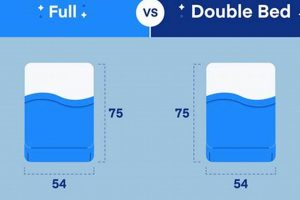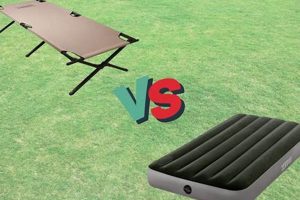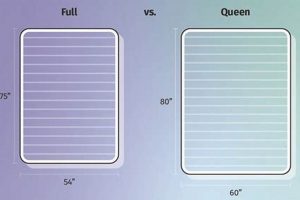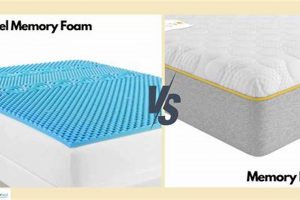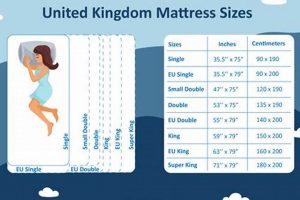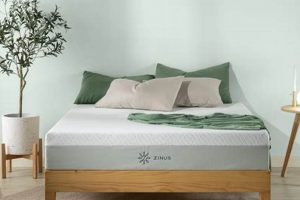The debate regarding bed dimensions frequently centers on the distinctions between a full and a queen-sized sleeping surface. A full, also known as a double, measures approximately 54 inches wide and 75 inches long. Conversely, a queen offers a more expansive sleeping area, spanning about 60 inches in width and 80 inches in length. For instance, a single adult might find a full adequate, while a couple often prefers the added space of a queen.
Selecting the correct bed dimension impacts sleep quality and bedroom aesthetics. A larger sleeping surface allows for increased freedom of movement, potentially leading to more restful sleep, particularly for couples. Historically, smaller dimensions were common due to space constraints; however, modern living often accommodates larger bed sizes, reflecting a greater emphasis on comfort and personal space.
The subsequent sections will delve into the specific factors to consider when choosing between these two dimensions, including room size, budget, and individual sleeping needs. This analysis will provide a clearer understanding of which option best suits different lifestyles and circumstances, allowing consumers to make an informed decision.
Considerations for Selecting Bed Dimensions
The decision between bed dimensions warrants careful evaluation. Prioritize factors impacting sleep quality, room space, and long-term satisfaction.
Tip 1: Assess Room Dimensions: Before considering dimensions, accurately measure the bedroom. Ensure sufficient space for movement around the bed and other furniture.
Tip 2: Evaluate Occupancy: Single sleepers might find a full adequate, while couples generally benefit from the increased width of a queen. Consider individual sleep habits and preferences.
Tip 3: Determine Budgetary Constraints: Bed frames, mattresses, and bedding costs vary significantly depending on the dimension. Establish a realistic budget and prioritize quality within that range.
Tip 4: Analyze Sleep Styles: Individuals who toss and turn frequently or prefer to spread out during sleep often benefit from the added space of a queen. This reduces the likelihood of disturbing a partner.
Tip 5: Project Future Needs: Consider potential changes in living arrangements or relationship status. Selecting a larger dimension provides greater flexibility for future needs.
Tip 6: Explore Mattress Types: Understand how different mattress types (e.g., memory foam, innerspring, hybrid) perform on various dimensions. Some materials are better suited for larger surfaces.
A thoughtful approach to dimension selection leads to improved sleep quality and overall well-being. These tips underscore the importance of considering practical needs and long-term satisfaction when making this decision.
The following sections will explore specific product recommendations and address common misconceptions surrounding dimension selection.
1. Room Dimensions
Room dimensions are a primary determinant when evaluating bed options. Available space directly impacts the feasibility and comfort of incorporating either a full or queen-sized sleeping surface. Insufficient space can lead to a cramped environment, hindering movement and diminishing the overall functionality of the bedroom.
- Minimum Room Size for a Full Mattress
A room intended for a full mattress should ideally measure at least 10 feet by 10 feet. This allows for sufficient space around the bed for movement and placement of essential furniture, such as a nightstand and dresser. Smaller rooms may accommodate a full mattress, but will likely feel more crowded and less functional.
- Minimum Room Size for a Queen Mattress
A queen mattress necessitates a larger room, typically requiring dimensions of at least 10 feet by 12 feet. This provides adequate space on all sides of the bed for comfortable movement and furniture placement. Attempting to fit a queen mattress into a smaller room can result in a significantly cramped and potentially unusable space.
- Impact on Room Aesthetics and Functionality
The mattress size influences the overall aesthetics and functionality of the room. A mattress that is disproportionately large for the room can visually dominate the space, making it feel smaller and less inviting. Conversely, a well-proportioned mattress enhances the room’s aesthetic appeal and allows for optimal use of available space.
- Consideration of Additional Furniture
When determining mattress size, account for other necessary furniture pieces. Dressers, nightstands, and chairs require floor space, and their placement should be considered in conjunction with the bed’s dimensions. Prioritizing a smaller mattress may be necessary to accommodate essential furniture and maintain a functional living space.
Therefore, a comprehensive assessment of room dimensions is crucial before deciding between mattress sizes. Failure to adequately consider spatial limitations can result in a suboptimal sleeping environment and reduced overall satisfaction. The interplay between room size and mattress size is a key determinant in bedroom design and functionality.
2. Occupancy Needs
Occupancy needs represent a critical factor when discerning between bed dimensions. The number of individuals regularly occupying the bed directly influences the required sleeping surface area and overall comfort level. Accommodating multiple occupants necessitates a larger surface to prevent sleep disturbance and ensure adequate personal space.
- Single Occupancy Considerations
For single individuals, a full mattress can provide sufficient space for comfortable sleep. However, a queen mattress offers additional room for movement and can be advantageous for individuals who prefer to spread out during sleep. The choice between the two depends on personal preferences and the desire for added space, rather than strict necessity.
- Dual Occupancy Requirements
For couples, a queen mattress is generally considered the minimum acceptable size to ensure adequate comfort and minimize sleep disruption. The increased width of a queen allows each individual to have more personal space, reducing the likelihood of waking a partner during the night. While a full might be physically possible for two adults, it is often perceived as cramped and uncomfortable for extended periods.
- Impact on Sleep Quality
Insufficient sleeping space due to inadequate mattress dimensions can directly impact sleep quality. Overcrowding leads to increased movement and disturbances, potentially resulting in restless sleep and reduced overall well-being. Selecting an appropriately sized mattress based on occupancy needs is essential for optimizing sleep quality and minimizing discomfort.
- Considerations for Pets or Children
The presence of pets or children in the bed further influences occupancy needs. If pets or children regularly share the sleeping surface, the requirement for a larger mattress increases. A queen mattress can often accommodate one or two small pets or children comfortably, while a full may become overly crowded in such scenarios.
Therefore, a comprehensive understanding of occupancy needs is paramount when deciding between bed dimensions. Neglecting to adequately consider the number of occupants and their individual sleeping habits can result in a compromised sleeping environment and reduced overall satisfaction. Aligning mattress size with occupancy requirements is crucial for achieving optimal comfort and restful sleep.
3. Budget Allocation
The allocation of financial resources significantly influences the choice between a full size and a queen size mattress. Mattress dimensions directly correlate with cost; queen mattresses, due to their increased material usage, typically command a higher price point than full mattresses. This price difference extends beyond the mattress itself, impacting the cost of associated items such as bed frames, bedding, and mattress protectors. Consequently, budget constraints frequently dictate which mattress dimension is a viable option for consumers.
For example, a consumer with a limited budget might prioritize a full mattress, allowing for the purchase of higher-quality bedding or a more durable bed frame within their financial means. Conversely, an individual with a larger budget may opt for a queen mattress, prioritizing comfort and space over cost considerations. The selection also extends to the mattress type; within a given budget, one might afford a higher-quality innerspring mattress in a full size, while the same budget might only allow for a lower-quality memory foam mattress in a queen size. Therefore, the financial implications are multifaceted, impacting both mattress size and overall quality.
In summary, budget allocation is a foundational consideration in the mattress selection process. The increased cost associated with queen mattresses influences consumer decisions, often necessitating a trade-off between mattress dimension, mattress quality, and the affordability of complementary items. Understanding the financial implications of each dimension allows consumers to make informed choices aligned with their budgetary constraints and comfort preferences, ultimately optimizing the value derived from their purchase.
4. Sleep Style
Sleep style, encompassing factors such as preferred sleeping position, movement during sleep, and temperature regulation, significantly influences the optimal mattress dimension. Restrictive dimensions can impede natural sleep movements, causing discomfort and disrupting sleep cycles. The effect of an undersized mattress is magnified for individuals who are active sleepers or prefer specific sleeping positions, potentially leading to fragmented sleep and reduced overall sleep quality. For example, a side sleeper on a full mattress might find their shoulders cramped, while a stomach sleeper may lack adequate space to comfortably position their arms. Therefore, understanding individual sleep style is paramount in selecting a mattress that promotes restful and undisturbed sleep. Selecting a larger dimension allows active sleepers to change positions without disruption, while side sleepers and stomach sleepers can enjoy ample space for their preferred posture.
To further illustrate the practical significance of sleep style, consider the scenario of two individuals with markedly different preferences. One individual might be a predominantly still back sleeper, finding a full mattress perfectly adequate. The other might be a restless sleeper who frequently changes positions throughout the night. For this individual, a queen mattress provides the necessary space to move freely without the constraint of reaching the mattress edge or disturbing a partner. Similarly, individuals who co-sleep with pets often benefit from the expanded space offered by a queen, accommodating both human and animal movement without sacrificing comfort. The practical application of this understanding lies in tailoring the mattress choice to match individual needs, leading to a more comfortable and restorative sleep experience.
In conclusion, sleep style is an indispensable component in determining the ideal mattress dimension. An awareness of individual sleeping habits, including preferred positions and movement patterns, facilitates an informed decision that prioritizes comfort and minimizes sleep disturbances. Ignoring these factors can result in a compromised sleep environment and reduced overall well-being. While budget and room size are crucial considerations, prioritizing sleep style ensures that the chosen mattress promotes restful sleep and aligns with individual preferences, ultimately contributing to long-term health and comfort.
5. Long-Term Use
The selection of a mattress dimension necessitates a consideration of long-term use, encompassing anticipated lifestyle changes and evolving needs. A decision based solely on current circumstances may prove inadequate as life circumstances shift. Therefore, projecting future requirements is crucial for ensuring enduring satisfaction with the chosen sleeping arrangement.
- Changes in Relationship Status
Relationship status significantly impacts mattress dimension requirements. A single individual may initially find a full mattress sufficient. However, the formation of a partnership necessitates a reevaluation. A queen mattress typically provides the minimum acceptable space for comfortable dual occupancy, accommodating two adults without undue crowding or sleep disturbance. Anticipating potential relationship changes allows for a proactive decision that avoids the need for future mattress replacement.
- Evolving Family Size
The addition of children or pets to a household influences long-term mattress needs. Children may temporarily or regularly co-sleep, requiring increased sleeping surface area. Similarly, pets often share the bed, further necessitating a larger dimension. While a full mattress may initially suffice, expanding family size often renders it inadequate, leading to discomfort and compromised sleep quality. Considering potential family growth enables a more adaptable and enduring mattress selection.
- Physical Health Considerations
Physical health can change over time, impacting mattress dimension requirements. The onset of chronic pain, mobility limitations, or sleep disorders may necessitate a larger mattress to facilitate comfortable movement and accommodate assistive devices. Conditions such as back pain or arthritis may benefit from the additional space afforded by a queen mattress. Planning for potential health changes ensures that the chosen mattress continues to support physical well-being in the long term.
- Relocation and Living Space
Potential relocation to a different living space can impact the suitability of the initial mattress dimension. A full mattress, while adequate for a smaller apartment, may appear disproportionately small in a larger bedroom, diminishing the overall aesthetic appeal. Conversely, a queen mattress may prove too large for a downsized living space, restricting movement and reducing functionality. Anticipating potential relocation allows for a mattress selection that remains adaptable to varying spatial constraints.
In conclusion, the long-term use of a mattress is inextricably linked to evolving life circumstances. A forward-thinking approach that anticipates potential changes in relationship status, family size, physical health, and living arrangements ensures that the chosen mattress dimension continues to meet evolving needs and provide lasting comfort and satisfaction. Neglecting this crucial aspect can result in premature mattress replacement and compromised sleep quality over time.
6. Mattress Type
Mattress type exerts a considerable influence on the perceived comfort and support characteristics of both full size and queen size mattresses. The internal construction and materials utilized within a mattress dictate its ability to conform to body contours, regulate temperature, and minimize motion transfer, all of which are amplified or diminished depending on the sleeping surface area.
- Memory Foam Density and Conformability
High-density memory foam, for instance, offers superior contouring and pressure relief compared to lower-density variants. This characteristic becomes particularly relevant in a queen size mattress, where the increased surface area allows for greater distribution of body weight and enhanced isolation of movement. Conversely, a full size mattress may exhibit less pronounced contouring effects due to the concentrated weight distribution. The selection of memory foam density should align with mattress dimension to optimize comfort and support.
- Innerspring Coil Count and Gauge
Innerspring mattresses rely on the number and gauge of coils to provide support. A higher coil count generally translates to improved support and durability. In a queen size configuration, a higher coil count ensures uniform support across the expanded surface. Conversely, a full size mattress with a similar coil count may exhibit a firmer feel due to the denser arrangement of coils. The coil gauge, which indicates the thickness of the wire, also influences firmness. A thicker gauge results in a firmer mattress, a characteristic that may be more noticeable in a smaller full size dimension.
- Hybrid Construction and Zoned Support
Hybrid mattresses combine the benefits of both memory foam and innerspring technologies. Zoned support systems, often incorporated into hybrid mattresses, provide targeted support to different areas of the body. This feature is particularly advantageous in a queen size mattress, where zoned support can effectively accommodate varying weight distribution and sleeping positions across the larger surface. A full size mattress may offer less pronounced zoned support due to the smaller surface area, potentially limiting its ability to cater to diverse sleeping needs.
- Latex Firmness and Responsiveness
Latex mattresses offer a responsive and resilient sleep surface. The firmness level of latex influences its suitability for different sleeping positions and body weights. A firmer latex mattress may provide adequate support for back and stomach sleepers, while a softer latex mattress may be preferable for side sleepers. The perceived firmness can vary depending on the mattress dimension; a queen size latex mattress may feel slightly softer due to the broader weight distribution compared to a full size variant with the same firmness rating. Choosing the appropriate latex firmness level is crucial for optimizing comfort and support, taking into account the selected mattress dimension.
The interplay between mattress type and dimension highlights the importance of considering both factors in tandem. The inherent characteristics of each mattress type, from memory foam to innerspring to hybrid, are either amplified or mitigated by the selected sleeping surface area. Consequently, an informed decision requires a comprehensive understanding of how mattress type interacts with mattress dimension to achieve optimal comfort, support, and sleep quality. The careful pairing of these elements allows for a personalized sleeping experience tailored to individual needs and preferences.
Frequently Asked Questions
This section addresses common inquiries regarding the distinctions between full and queen-sized mattresses, providing clarity on factors relevant to making an informed purchasing decision.
Question 1: Is a full size mattress adequate for two adults?
A full size mattress, measuring 54 inches in width, is generally considered insufficient for comfortable dual occupancy. The limited space per individual can lead to sleep disturbance and reduced overall comfort. A queen size mattress, with its additional width, is typically recommended for couples.
Question 2: What is the minimum recommended room size for a queen size mattress?
A queen size mattress requires a room dimension of at least 10 feet by 12 feet to allow for comfortable movement around the bed and placement of other furniture. Smaller rooms may feel cramped and restrictive with a queen size mattress.
Question 3: Does a queen size mattress always cost more than a full size mattress?
Yes, a queen size mattress generally commands a higher price point than a full size mattress due to the increased material usage. This price difference extends to associated items such as bed frames and bedding.
Question 4: How does mattress type impact the choice between full and queen size?
Mattress type influences the perceived comfort and support characteristics across both dimensions. Memory foam, for instance, may exhibit enhanced contouring on a queen size mattress due to increased surface area. Innerspring coil count affects support, while hybrid construction offers zoned support advantages on a queen size. Select mattress type considering the interplay with the chosen dimension.
Question 5: Should long-term needs be considered when choosing between mattress sizes?
Yes, anticipating potential changes in relationship status, family size, and physical health is crucial. Selecting a larger dimension, such as a queen, provides greater flexibility for evolving needs and avoids premature mattress replacement.
Question 6: Can a full size mattress accommodate a single adult comfortably?
A full size mattress typically provides sufficient space for a single adult. However, individuals who prefer to spread out during sleep or anticipate sharing the bed with pets may find a queen size mattress more comfortable.
These answers provide a foundation for understanding the key considerations when evaluating mattress dimensions. Understanding these factors allows for a more informed decision-making process.
The subsequent section will delve into specific product recommendations and purchasing strategies.
Full Size vs Queen Size Mattress
This exploration of “full size vs queen size mattress” has underscored the multifaceted considerations inherent in selecting an appropriate sleeping surface. Room dimensions, occupancy needs, budgetary constraints, sleep style, long-term use projections, and mattress type all converge to influence the optimal choice. A thorough assessment of these factors is paramount for maximizing comfort, promoting restful sleep, and ensuring long-term satisfaction.
The information presented serves as a foundation for informed decision-making. Potential purchasers are encouraged to carefully weigh individual circumstances against the characteristics of each mattress dimension. Neglecting these considerations can lead to a compromised sleep environment and reduced overall well-being. Ultimately, the decision between “full size vs queen size mattress” should be grounded in a pragmatic evaluation of personal needs and anticipated future requirements.


